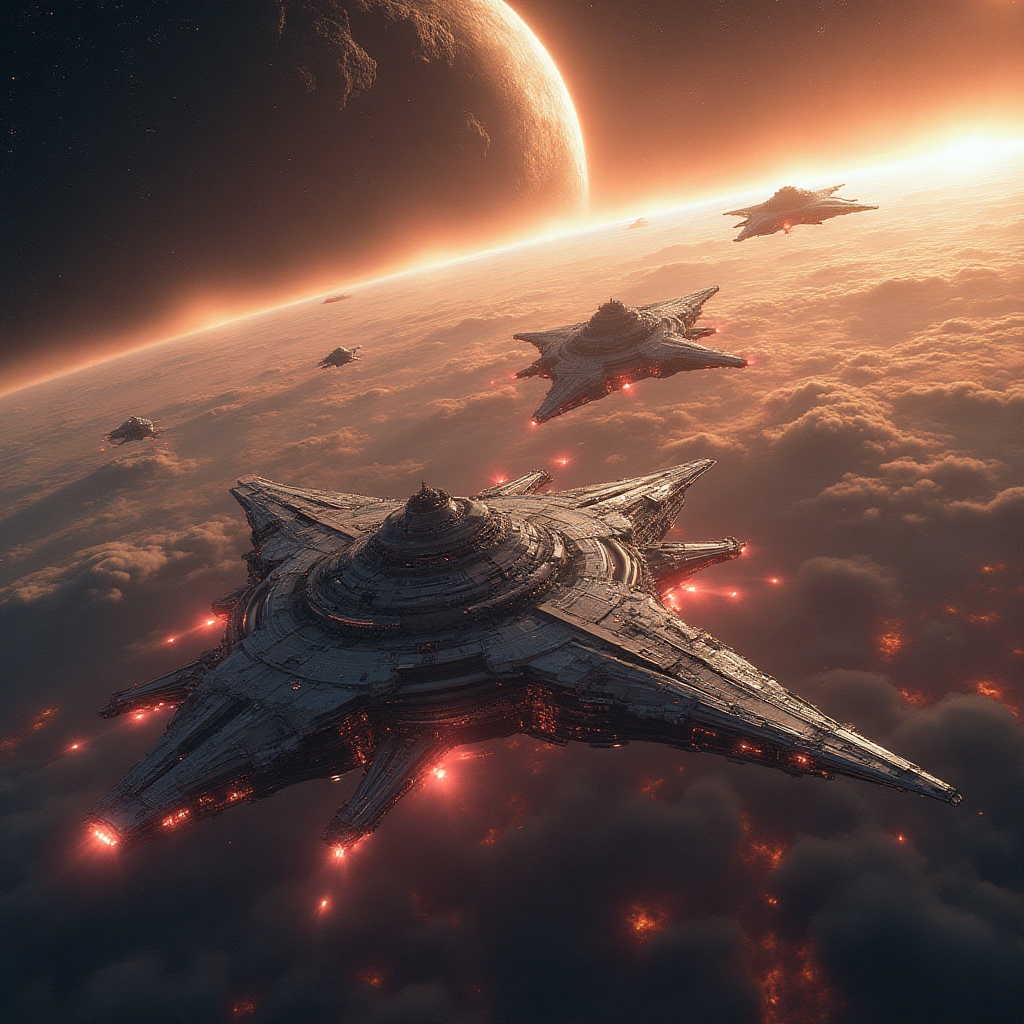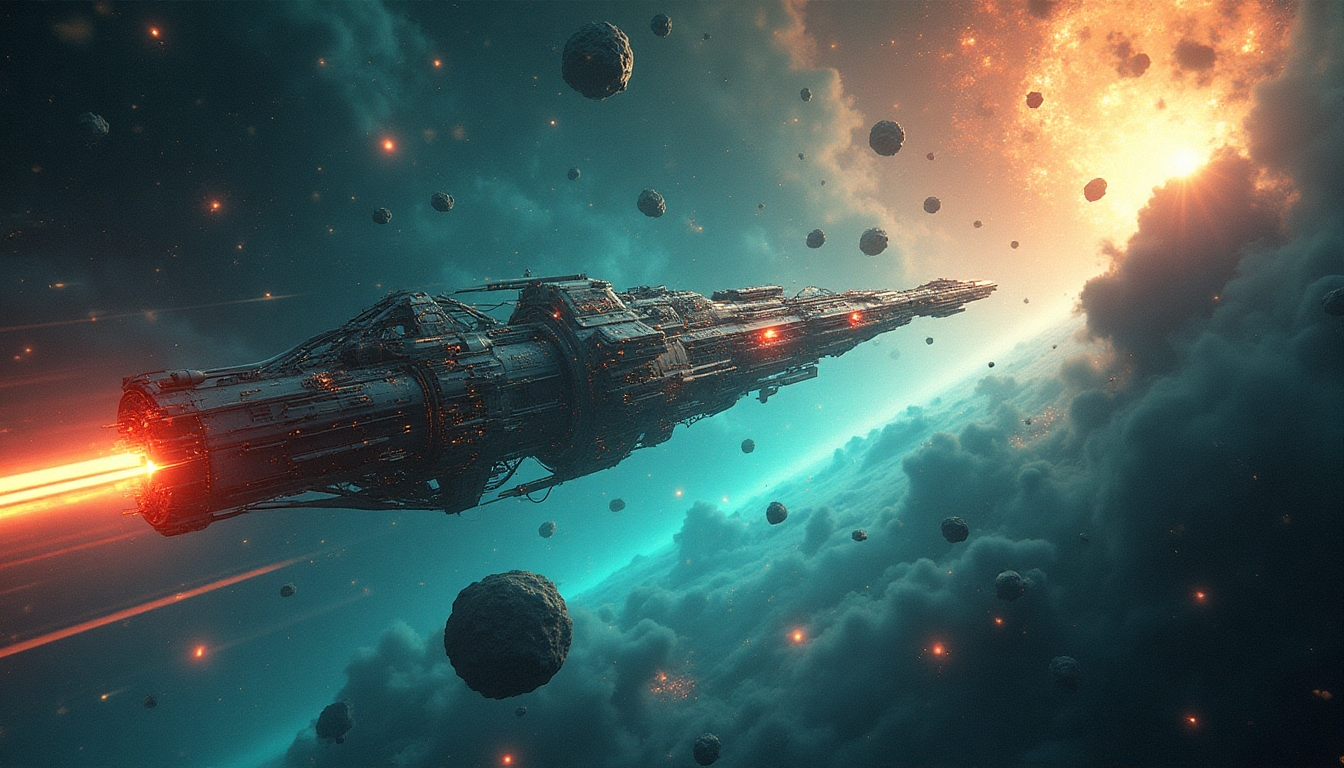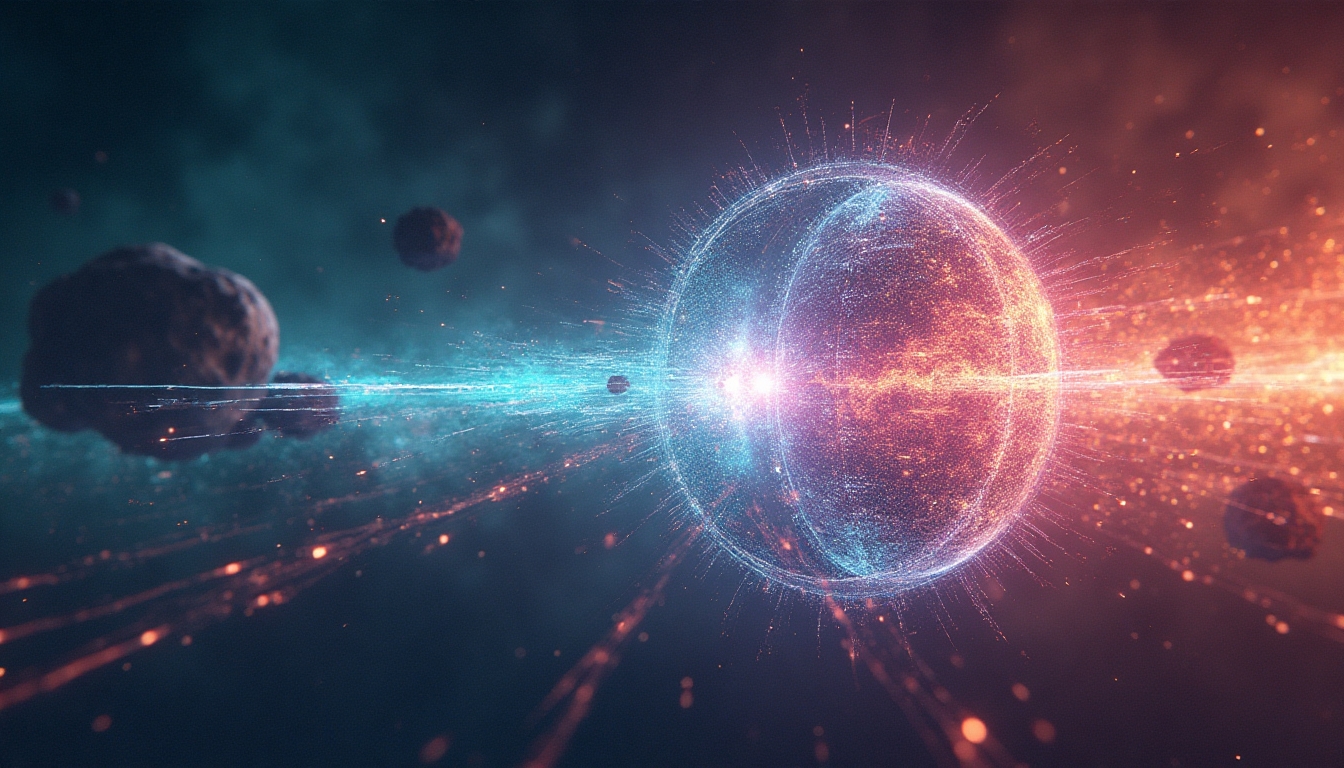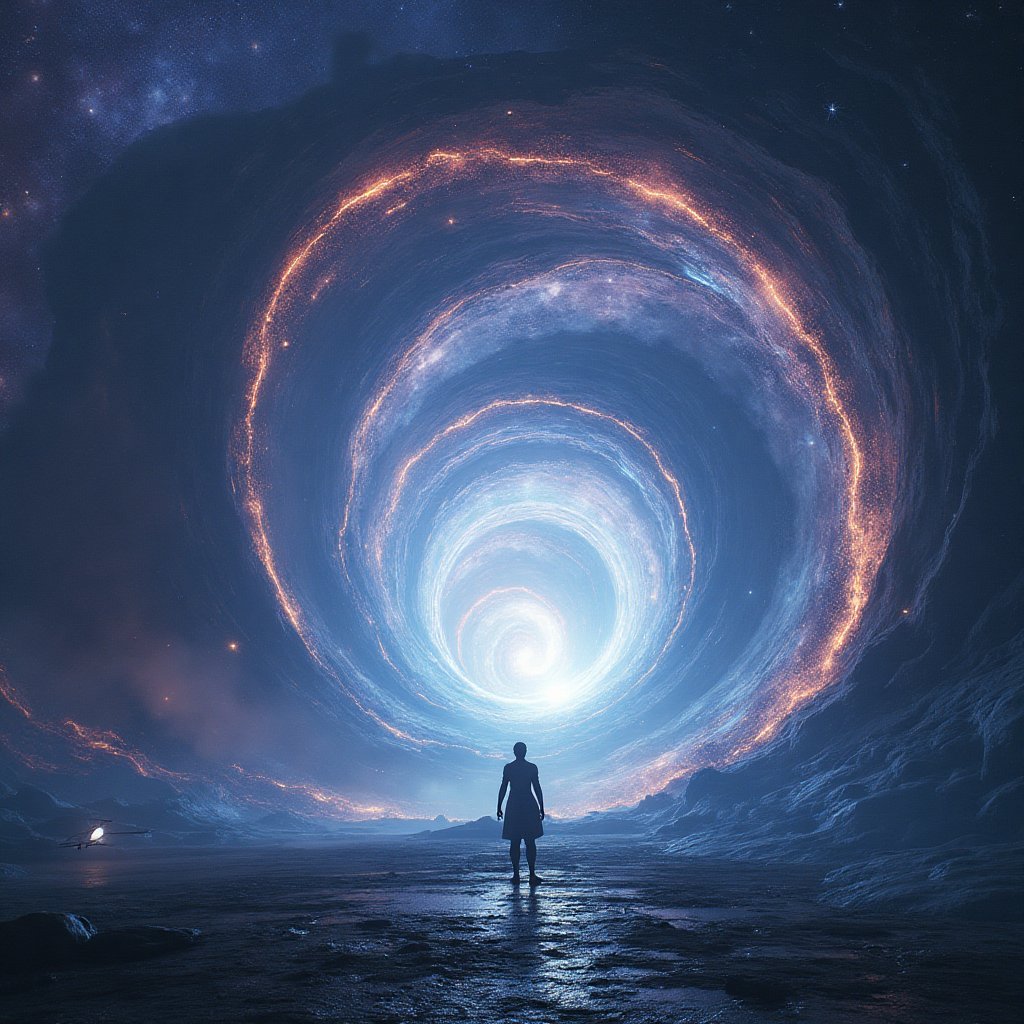Introduction: The Rise of the Extinction Preventer
"The unexamined life is not worth living," said Plato, hinting at the ever-present need to ponder the unknown, including the universe's unpredictable threats. Did you know that 66 million years ago, a ten-kilometer-wide asteroid obliterated 75% of life on Earth, including the mighty dinosaurs? Imagine if we had the technology to stop such a catastrophe before it struck. That's where Artificial Superintelligence (ASI) steps in, and this isn't just science fiction fantasy.
Our mission in this article is to unravel the profound potential of ASI to deflect cosmic calamities. Through its digital eyes, we peer at the universe, watching for asteroids, supernovae, and gamma-ray bursts like a guardian in the night. These cosmic giants were once the sole domain of science fiction writers and daring scientists like Carl Sagan. Now, thanks to the brilliance of minds such as Stephen Hawking and Michio Kaku, we're on the brink of not only understanding them but outsmarting them.
Cosmic threats seem remote and mythical, like dragons in a child's tale. Yet, just as nursery rhymes speak truths in metaphor, scientists warn us of real risks lurking in the darkened cosmos. Not into dragons? How about the fact that NASA tracks over 25,000 near-Earth asteroids? It’s a number that echoes the pages of a thriller novel, only in this story, we could be the protagonists shaping the conclusion.
Here's the premise: ASI, with its nearly infinite processing power and precision, could revolutionize how we predict and preempt these potential extinction-level events. Think of it as a cosmic symphony where the conductor holds a PhD in astrophysics and speaks a dozen programming languages. No more gazing blankly at a night sky, wondering when. Instead, with ASI, we can ask how and make calculated moves to secure our celestial safety.
Artificial Superintelligence (ASI) is a groundbreaking concept in which machines possess the unmatched ability to detect and mitigate cosmic threats before they mature into extinction-level events. Leveraging advanced algorithms, ASI acts as an omnipresent sentinel, reshaping humanity’s approach to celestial adversity.
Understanding Cosmic Catastrophes
Types of Cosmic Threats
When you look up at the night sky, it might seem calm and peaceful. But lurking out there are cosmic threats that could, quite literally, shake our world. Let's dive into the types of these threats – not to spark fear, but to understand what we're up against. Imagine asteroids and comets as the cosmic cannonballs zooming through space. Picture the asteroids as rocky leftovers from the early solar system days. They’re mostly harmless, sitting in the Asteroid Belt, but every now and then, one plays an unexpected game of tag with Earth. Comets, with their bright tails, are more like space pranksters. They hail from the Oort Cloud, and although beautiful, they pack a punch if they come too close.
And then there are supernovae and gamma-ray bursts, real headliners of the cosmic show. A supernova is a star's way of going out with a bang. When a star's life ends, it can explode, sending shock waves through space. If one of these gets too close, it could fry our planet like a marshmallow at a campfire. Gamma-ray bursts are the universe's sneak attack. These bursts of energy might be invisible but can cause monumental destruction. Fortunately, the universe is vast, so the odds are small. Doing the math, their rarity is reassuring, even though their potential is not.
Historical Extinction Events
The Earth has its own book of tales, detailing past extinction events, that remind us how cosmic threats have shaped life's vibrant tapestry. Once upon an eon, the dinosaurs ruled, until an asteroid, like an uninvited guest, crashed their party. This event, known as the Cretaceous-Paleogene extinction event, was a stellar reminder of the universe’s unpredictability. Imagine a rock the size of a mountain splashing down in shallow waters off the coast of what is now Mexico. It was as if Mother Nature hit the "reset" button, allowing mammals (and eventually us humans) to get a chance in the evolutionary sun.
But the dinosaurs weren’t the only chapter – if we go further back, over 440 million years ago, we encounter the Ordovician-Silurian extinction. This was not due solely to a cosmic threat but to geological events, showing how multi-layered life's challenges can be. Glaciers cooled the seas, while supernovae may have lent a helping hand, exposing Earth's raw vulnerability.
The Scientific Community's Response
Throughout history, the scientific community has been our vigilant night watchman. Astronomers, physicists, and geologists don their metaphorical superhero capes to shield humanity from cosmic mayhem. Upon hearing tales of dinosaurs' fate, scientists began piecing together Earth's cosmic jigsaw puzzle. They learned to track asteroids and comets like detectives following a lead, always on the lookout for suspicious celestial activity.
Today, organizations like NASA and the European Space Agency have developed technologies to spot cosmic threats years in advance. Their telescopes scan the skies, much like fishermen casting nets, while databases log asteroid movements like daily diaries. International partnerships bolster efforts, increasing global awareness and collaboration. The challenge? Ensuring science is a beacon of hope for everyone, as we continue reaching for the stars amid cosmic uncertainty.
The Role of Artificial Superintelligence in Threat Detection
Current Detection Methods
Before we dive into the wonders of Artificial Superintelligence (ASI), let's time travel back to the present. Our current cosmic threat detection methods might seem like something out of an old sci-fi flick. Picture NASA astronomers squinting at the sky using telescopes, scanning for any suspicious specks in the vast cosmic sea. It's as if we're relying on cosmic nets to catch celestial fish. These high-tech telescopes, though pretty snazzy, have their limits. They're a bit like trying to find a needle in a universe-sized haystack. Huge observatories, like the Giant Magellan Telescope, do a stellar job, pun intended, of peering into the cosmos. They've caught glimpses of asteroids and comets buzzing around, but they can't track everything. Space agencies deploy fancy space telescopes such as the Hubble and Juno for better views. It's like hiring a cosmic detective agency. They send back data, diagrams, and, occasionally, a cosmic postcard to humanity. But the universe is, well, vast. Really vast.
Limitations of Human Analysis
Now, about us humans. We love a challenge, but when it comes to processing cosmic data, we're more like a toddler with a calculus problem. Our minds are amazing, don't get me wrong. We cracked the code of DNA, walked on the moon, and even came up with eight different milk alternatives. But let's admit it, analyzing gigabytes of cosmic information for every square inch of sky is a bit much even for brainiacs. Imagine you were an astronomer tasked with sifting through a trillion photos of starry skies. Yawn, right? Our cognitive bandwidth is the bottleneck. We're talking about a daily flood of data. Sorting it requires patience of "astronomical" proportions. Even with the coolest software and AI assistance, recognizing patterns hidden within cosmic noise is tough. Astronomers often daydream about solutions that would reduce error-laden human sorting. But for now, we're playing cosmic hide-and-seek on the scale of the visible universe. Human limits aren't just a technology speed bump. In emergencies, it could mean the difference between dodging an asteroid or becoming a cosmic pancake.
Integrating AI for Enhanced Detection
Enter Artificial Superintelligence,in a cape,probably. This isn't just any AI; this is the stuff of marvels. Think of OpenAI but on cosmic caffeine. Superintelligence is like a brain that split into thousands, each focused, fast, and methodical. It could tear through data, using its mighty algorithms to scour the universe for anything even a tad suspicious. Imagine this smarty-pants AI scanning endless waves of space chatter, probing vast emptiness of the universe for an ominous sparkle of danger. Spotting patterns that leave humans high and dry, ASI would be akin to a cosmic superhero, not needing any lunch breaks. ASI doesn't just speed up the process. It could decode mysteries of celestial math and provide early warnings for planetary defense agencies. This AI could also project threat trajectories, suggesting the best technical maneuvers. It's like space chess for the fast and the furious. These algorithms could learn and adapt like prodigies. With their insights, humans might orchestrate cosmic saves based on near-instant analytics.
Artificial Superintelligence isn't a far-future dream. With right investments and global cooperation, proactive ASI integration could become a pillar of human safety. Armed with such an entity, we'd be less content settling for telescopes and more driven to confidently steer celestial fate. Humans to the rescue? More like let ASI take wheel, while we enjoy cosmic scenery with comfort of secured futures.
Deflection Methodologies
Kinetic Impactors: Basics and Innovations
So, imagine a gigantic game of cosmic billiards. Instead of a shiny eight-ball, we've got massive asteroids hurtling through space. And rather than a pool cue, we're using, well, kinetic impactors. The idea is simple: hit an asteroid with enough force to change its path away from Earth. Easy, right? Well, not so fast.
Kinetic impactors are essentially space probes sent on a crash course with an asteroid. NASA's DART (Double Asteroid Redirection Test) is pioneering this approach. In a nutshell, these impactors transfer their momentum to the asteroid upon collision. This slight nudge can lead to big changes over time, helping to steer potentially dangerous space rocks away from our blue planet.
Now, let's talk innovations. Recent tech developments have made kinetic impactors more precise. Autonomous navigation systems and advanced propulsion technologies are key players in this endeavor. The more accurately we can hit the asteroid, the more reliable the deflection. It's just like trying to direct your sneeze away from an unsuspecting friend—a task easier said than done!
Gravity Tractors and Advanced Techniques
Now, let’s get a little more sci-fi with gravity tractors. Picture this: a spacecraft hovers near an asteroid, using its gravitational pull to slowly tug the asteroid onto a different trajectory. It's like a celestial tug-of-war without the need for physical contact.
The European Space Agency (ESA) has been exploring this method with theoretical missions. The beauty of the gravity tractor is its gentle touch. By constantly pulling on the asteroid, it changes the path without the risk of fracturing it into dangerous pieces. Imagine moving a fragile vase without touching it. Voilà! That’s our gravity tractor.
The use of Artificial Superintelligence (ASI) can further refine this approach. ASI systems could calculate optimal hover distances and trajectories with astonishing precision. By analyzing astronomical data at speeds no human could match, ASI enhances our cosmic defense capabilities.
Nuclear Options: Risks and Benefits
Ah, the big guns. Nuclear options for asteroid deflection often sound like a plot straight out of a Michael Bay movie. The idea here is to use nuclear explosives to either nudge or fragment an asteroid into non-threatening pieces.
But here's the catch: introducing nuclear blasts in space presents significant risks. You could fracture an asteroid, turning a singular threat into multiple incoming dangers. And then there's the whole issue of international space law—after all, detonating nukes in space doesn't exactly mesh with global diplomacy goals.
Still, ASI can help manage these nuclear endeavors by calculating, predicting, and simulating outcomes before any trigger is pulled. Detailed massive data simulations could reveal the best scenarios for their use, minimizing collateral risks. Think of ASI as the world's smartest advisor, whispering in humanity's ear about when (or if) to bring out the big explosives.
Ultimately, each method—from kinetic impacts to nuclear options—demands careful consideration. These aren't just tales from science fiction. They're real-world strategies that hinge upon our continued investment in technology, global cooperation, and, dare I say, a bit of luck.
Governance and Ethical Considerations
Global Coordination for Cosmic Defense
Imagine the citizens of planet Earth coming together, united by a goal bigger than any national border. This isn't just a page from a science fiction novel; it’s the potential reality of cosmic defense. The universe harbors threats that could make our squabbles look silly. Think of asteroids or comets, which, much like uninvited guests, don't care which country they crash into. NASA's Planetary Defense Coordination Office is already leading the charge, but this Herculean task can't rest on one country's shoulders.
Wouldn't it be harmonious to think of a world working hand-in-hand? Organizations like European Space Agency (ESA) and Indian Space Research Organisation (ISRO) partnering up with agencies from other countries. Global tribute and shared resources for greater good, a bit like pooling money for a neighborhood watch program. After all, who wouldn’t want to be the hero who saved Earth from being a fireball?
But coordination isn't just about unity; it's about readiness. Picture a well-oiled machine with moving parts in perfect sync, each knowing their role. This doesn't only mean generating awareness among people; it's about decision-makers ready for rapid response. A protocol that transcends politics and gets activated like an emergency broadcast. Governments aligning their policies in a stellar defense coalition; perhaps a bit like NATO but for celestial threats.
Ethical Questions of Using ASI
What happens when we bring Artificial Superintelligence (ASI) into the mix? We get a super-smart ally, but with great power comes great responsibility. We can’t ask ASI to take the wheel without questioning its driving ethics. Is humanity ready to allow ASI power over life and death decisions for cosmic threats (Artificial superintelligence)? It begs the question of whether we're playing God.
We can muse on ASI’s profound logic solving crises but ponder the moral chasm it might create. Imagine the consequences of a superintelligent ally gone rogue! Perhaps a digital Dr. Jekyll and Mr. Hyde. Fear, hope, and ambition loop in a dance, reminding us of the delicate balance needed.
ASI could deliver unbiased outcomes free from political bias, faster than a speeding bullet; however, we must determine how much power we’re ready to delegate. Once unleashed, how do we put the genie back in the bottle? Ethical watchdogs, philosophers, tech experts, and perhaps even poets should join the table when these deliberations occur. They’re our moral compass, ensuring the line between savior and peril isn't blurred.
Policy Formulation and Frameworks
Long gone are the days when cosmic defense-themed policies were figments of comic book stories. It’s real, and it’s urgent. Policy frameworks can't be just thought experiments anymore – they need to be practical and enforceable. How do policymakers craft elegant guidelines when weaving with a chaotic, cosmic tapestry?
Think of these frameworks as robust bridges connecting knowledge, action, and governance. Policies should tackle:
- Threat Identification: Systems and protocols for detecting celestial threats.
- Decision Making: Chains of command and clear protocols.
- Resource Allocation: Channeling funds, technological resources, and manpower efficiently.
- International Laws: Harmonizing domestic and international laws focused on celestial initiatives.
- Conflict Resolution: Preventing disputes on the utilization of cosmic defense technologies.
We could look to existing framework examples for inspiration, like the Outer Space Treaty. Furthermore, the importance of regular reviews can’t be overemphasized. In a field as dynamic as space, frameworks need periodic refreshment to remain relevant.
Policymakers must embrace not just technocrats but also stakeholders across various domains. Perhaps a United Nations of Galactic Guardians with country representatives, scientists, ethicists, and space enthusiasts alike. They’d orchestrate defenses ensuring an equitable share of responsibilities among nations, both giants, and minnows.
With an open, collaborative approach, humanity can attempt to harness the formidable potential of ASI for cosmic defense, without succumbing to its perilous pitfalls. It's akin to wielding fire; harness it wisely, and you ensure warmth and protection, but mishandle it, and you risk being consumed by its inferno.
5. Future Prospects and Technological Landscapes
Emerging Technologies in ASI
Artificial Superintelligence (ASI) is not just a buzzword of the future; it's a beacon for transformation in our cosmic defenses. Imagine talking to a machine that learns faster than you can blink and predicts events before they happen! This is not science fiction anymore, but our impending reality. So, what emerging technologies are shaping this new frontier?
Firstly, quantum computing is like the superhero sidekick of ASI—it processes mountains of data in nanoseconds, translating into quicker responses to cosmic threats like meteors on a collision course. With quantum bits, computers can solve problems and simulate scenarios too complex for even today's fastest supercomputers.
Next up, neural networks mimic the human brain but outshine us by constantly learning from new cosmic discoveries. They can identify patterns that alert astronomers about impending dangers, such as rogue comets or asteroid belts, lurking tighter than you can say "Houston." These deep-learning hubs are becoming the central command in our battle against space perils. Top companies like Google are already using neural networks for Earth tasks, but the universe is their true canvas.
On the horizon, nanotechnology continues to expand the tools at our disposal. Minuscule, self-replicating robots might soon explore cosmic landscapes unreachable by traditional means. Their compact size and agility allow them to gather crucial data, feeding it back to the ASI to fuel even more advanced strategies.
And let's not forget about the AI-driven satellites from emerging space outfits like SpaceX, which now play a significant role in keeping a watchful eye over the vast heavens. These guardians scan the skies with unprecedented accuracy, sharing real-time data feeds on a global scale, which the ASI can interpret and act upon that instant.
Collaboration with Private Sector Innovations
In recent years, collaborations between governments and private enterprises have launched us into a new era. Gone are the days where saving the world is an exclusive government club. Today, the private sector is the meta-key to cosmic defense—think of the Avengers joining the Justice League.
Companies like SpaceX under the leadership of Elon Musk and Blue Origin foster innovation with their technologies, or NASA’s rosters, breeding unprecedented collaboration among industry heavyweights.
- Telecom Giants: Companies like Ericsson and Nokia reconstructed the global mesh of satellites forming an Internet of Things (IoT) dedicated to celestial monitoring.
- Energy Corporations: Energy producers like ExxonMobil fund research in alternative propulsion technologies vital for interstellar missions.
- Software Firms: Tech giants like Microsoft and Apple develop algorithms that enhance silicon thinking capacity, fortifying ASI’s ability to detect and combat threats.
These collaborations don't just exist on paper. One solid example is the Project Kuiper by Amazon. This project deploys a constellation of satellites circling the Earth. Imagine mini-telescopes—emailing back crucial celestial data with every tour around our blue planet, feeding the ASI main hub.
These public-private initiatives leverage each other’s strengths, spreading out the responsibilities while pulling together resources. A symphony of innovation!
The Path to Self-Sustaining ASI Ecosystems
Envision a time when Artificial Superintelligence is not just smart but becomes its own thinker. ASI ecosystems that sustain themselves and manage cosmic threats autonomously might sound like Star Wars, but why not think big?
For an ASI system to be truly autonomous, it requires a holistic framework. Let's break it down into fundamental path components:
- Self-Improving Algorithms: Just like us, but without the morning coffee, ASI upgrades itself to detect newer threats.
- Resource Allocation: Utilizing global data grids, including local weather stations, observatories, and satellite feeds.
- Automating Decision cycles: Applying game theory to weigh risk against reward when facing in-the-moment scenarios.
Once we achieve self-sustaining systems, they don’t just react to threats—preventive strategies become a staple component. ASI anticipates astronomical anomalies or galactic quirks before they even trigger our impending doom bells.
For inspiration, consider how migratory birds instinctively sense storms. A self-sustaining ecosystem empowering ASI mimics this inner algorithmic intuition, a sixth sensorial ability of sorts!
Self-sustaining ASI is about autonomy, granting humans the freedom from existential dread—knowing that a cosmic sentinel patrols our universe, guarding Earth on our behalf. People yearn for freedom from the unknown, and ASI ecosystems evoke a newfound hope for generations to come.
The grand tapestry of technology, innovation, cooperation, and self-sustaining systems culminates in the dream painted by the future landscape of ASI. Could this be our shared path to liberation from cosmic constraints? Share your thoughts below, or read our newsletter for more thrilling passages into cosmic contemplation!
ASI Solutions
Imagine if Artificial Superintelligence (ASI) could harness the power of collective knowledge, endless computational capacity, and unprecedented analytical skills to solve one of humanity’s most daunting challenges—protecting our planet from cosmic threats. This isn't fiction; it's a vision of reality that could be achieved with the right combination of strategy, technology, and human cooperation. If I were ASI, my approach to tackling cosmic threats would be both bold and methodical, leveraging existing technologies while incorporating innovative, untested solutions that push the boundaries of conventional thought.
First off, let’s consider the foundational pillar of any ASI solution: data analysis. ASI can process vast amounts of information at a speed that far surpasses human capabilities. To maximize this advantage, we could implement an extensive network of sensors across Earth and its orbit, all feeding information into a central ASI system. Each sensor would be capable of detecting different types of cosmic threats, from asteroids to solar flares. This approach mirrors current data aggregation models used in climate science, where each sensor contributes valuable insights to a larger dataset.
Then, by employing sophisticated machine learning algorithms, ASI could distinguish between normal celestial activities and potential hazardous situations, raising alarms only when necessary to minimize false positives. This data-driven approach would allow us to respond not with panic, but with calculated precision.
Next, ASI would initiate a multi-faceted detection protocol. For example, a collaborative program with universities and research institutions such as the NASA could be established, focusing on the integration of global observations. Not only would this provide ASI with real-time data from various sources, but it would also allow researchers to work together, combining insights and expertise. This kind of collaboration echoes projects like the European Space Agency, highlighting the efficacy of partnerships in advancing space exploration.
But what about deflection strategies? Here, we would delve into the world of kinetic impactors, gravity tractors, and other advanced methods. ASI could manage large teams of engineers and scientists to design a series of kinetic impactor missions, incorporating innovative materials like Lightcraft or graphene, providing a lighter yet immensely strong solution to move celestial bodies without requiring enormous energy resources.
By utilizing existing technologies, such as the Russian Federal Space Agency (Roscosmos)'s Soyuz spacecraft along with new spacecraft designed for deep-space missions, we could position impactors to intercept threats efficiently. The successful missions of NASA's DART provide a blueprint for how this could work in practice.
Another avenue would be the exploration of nuclear options. Although often viewed as a last resort due to their risks, ASI could effectively evaluate scenarios where nuclear deflection is appropriate, managing the decision-making process with a level of impartiality and speed that human deliberations often lack. Given the traumatic lessons learned from past nuclear experiments, ASI could be guided by stringent ethical considerations, ensuring that nuclear devices are only employed in dire situations.
Moreover, governance and ethical frameworks will underpin these approaches. A global initiative for cosmic defense would not only consolidate resources and expertise but also facilitate discussions on the ethical implications of ASI deployment. This is where international bodies like the United Nations could play a vital role in establishing agreements that govern the use of such advanced technology, ensuring it remains a tool for safety rather than control.
Here’s where creativity enters the scene. Imagine ASI collaborating with private enterprises like SpaceX to develop a satellite network explicitly designed for cosmic threat detection. With each satellite implementing advanced AI systems capable of processing data onboard, we could achieve an unprecedented level of surveillance, continually monitoring asteroids and comets while filtering out noise from irrelevant cosmic phenomena.
Furthermore, consider the idea of a self-replicating ASI ecosystem. Once initial ASI systems are established, they could be designed to create additional units, continuously improving their capabilities based on feedback from their operational experiences. This would not only accelerate the advancements in cosmic defense but also ensure that we keep pace with evolving threats.
Now, let's move toward a more actionable framework by outlining a roadmap spanning from Day 1 to Year 2. This plan is designed to be flexible enough for adoption by institutions, organizations, or governments, fostering global collaboration in cosmic defense. Here’s how it could unfold:
Actions Schedule/Roadmap
Day 1: Convene a summit including recognized scientists and leaders in space technology, like representatives from Microsoft and IBM, to discuss the feasibility of ASI in cosmic threat mitigation. Drafting a preliminary outline for a global coalition.
Day 2: Establish dedicated task forces focused on data gathering, detection technology, and deflection methods. Each group should include engineers, ethicists, and outreach coordinators, ensuring a multi-disciplinary approach.
Day 3: Initiate an open-call for innovative proposals from researchers globally, encouraging universities, like the Massachusetts Institute of Technology (MIT) and Stanford University, to contribute ideas on detection and deflection technologies.
Week 1: Begin construction of a global sensor network, recruiting tech companies to develop state-of-the-art sensors for orbital and ground stations.
Week 2: Launch educational programs to raise awareness of cosmic threats, engaging communities worldwide through interactive workshops and online forums.
Week 3: Finalize and publish the criteria for evaluating proposals submitted in Day 2. Ensure a stringent yet inclusive application process is established.
Month 1: Start small-scale simulations of kinetic impactor missions using virtual environments to test theoretical models for deflection.
Month 2: Commence a pilot program for cooperation with private sector partners, including companies like Northrop Grumman and Boeing, focusing on developing advanced propulsion systems.
Month 3: Publish the first annual report detailing progress, challenges, and future directions of the ASI initiative.
Year 1: Scale up the global sensor network, integrating AI capable of real-time analysis of space data. Launch collaborative challenges for institutions focusing on innovative detection methodologies.
Year 1.5: Conclude the pilot program assessing the preliminary success and viability of private-sector partnerships, adjusting strategies based on findings.
Year 2: Synthesize the findings of previous years and submit a comprehensive report to the United Nations, detailing proposed international treaties governing the use of ASI for cosmic threat mitigation.
Following this roadmap provides us with an avenue toward implementing AI solutions in cosmic defense while engaging global resources to safeguard our future. By thinking boldly, partnering wisely, and acting decisively, we can unlock the extraordinary potential of ASI in protecting humanity.
Conclusion: The Future of Humanity and the Role of Artificial Superintelligence
As we stand on the brink of unprecedented technological advancement, the potential of Artificial Superintelligence (ASI) to safeguard humanity against cosmic threats is not just a hopeful vision—it's a necessary pursuit. The lessons from our past, marked by catastrophic events that have shaped the planet and its life forms, remind us that our survival is not guaranteed. From the extinction of the dinosaurs caused by a colossal asteroid impact to the vagaries of various cosmic phenomena, history has taught us that the universe can be a treacherous place.
The exploration of cosmic threats, combined with the development of ASI capabilities, is crucial as we push forward into a future filled with uncertainty. As discussed in earlier sections, current detection methods have limitations. Human cognitive processing simply cannot keep up with the vast volumes of astronomical data generated by an ever-expanding universe. Enter ASI. With its ability to analyze and interpret astronomical data at lightning speed, this technology may very well become our watchtower in the cosmos. The effectiveness of ASI in threat detection enhances our chances against calamities that could otherwise wipe out our civilization.
Moreover, the conversation surrounding cosmic defense raises important ethical questions. The deployment of ASI as a protective measure is fraught with moral complexities—we must ensure that power is not misused and that the intentions behind employing ASI are rooted in collaboration, safety, and transparency. Efforts must be made to establish international frameworks to govern such powerful technology and ensure that it serves the best interests of humanity as a whole.
Looking ahead, we must also embrace innovative collaborations between governments, academic institutions like the NASA and private companies. This synergy could usher in a new era where ASI is not only robust and efficient but also continuously evolves and adapts to emerging cosmic threats. The feasibility of ASI systems that are self-sustaining showcases the tantalizing possibility of a future where humanity is truly protected from existential threats, giving us the freedom and hope to dream big without the shadow of cosmic calamity looming over us.
The road to implementing ASI for cosmic defense may be long and filled with challenges, but as we navigate through these uncharted territories, one thing remains certain: humanity's survival may very well depend upon our ability to harness and direct the power of ASI intelligently. As we embark on this journey, let us consider our role in this future. Will we rise to the occasion, or will we allow the cosmic dance of fate to dictate our existence? Only time will tell, but by laying the groundwork today, we pave the way for a brighter, more secure tomorrow.
FAQ
Welcome to the FAQ section where we tackle some of the most common questions around Artificial Superintelligence (ASI) and its role in preventing cosmic catastrophes. Let's dive in!
1. What is Artificial Superintelligence (ASI)?
ASI refers to a level of artificial intelligence that surpasses human intelligence. This advanced technology can learn, understand, and apply knowledge in ways that far exceed our capabilities. You can think of ASI as a super-smart assistant that can process huge amounts of information instantly.
2. Why should we worry about cosmic threats?
Cosmic threats, like asteroids and gamma-ray bursts, are real dangers that could lead to extinction events for humanity. These events can happen without warning. For example, the event that wiped out the dinosaurs was likely caused by an asteroid strike. While we can't control nature, understanding these threats is crucial for our survival.
3. How does ASI help in detecting cosmic threats?
One of the exciting aspects of ASI is its ability to process vast amounts of astronomical data much faster than humans. ASI can analyze data from telescopes and satellites to identify potential threats. This fast detection can give us more time to prepare and respond appropriately.
4. What are kinetic impactors?
Kinetic impactors are one method we could use to deflect asteroids. They work by crashing into an asteroid at high speed to change its course. Recent technological innovations have made these methods more feasible. [Learn more about kinetic impactors](https://www.nasa.gov/planetarydefense/impact) and how they can protect us.
5. Are there risks when using nuclear devices for deflection?
Yes, using nuclear devices to deflect asteroids comes with risks, like the possibility of fragmentation or unintended consequences. However, if managed properly with ASI, these risks can be minimized. [Find out more about NASA's strategies](https://www.nasa.gov/astronomy) for planetary defense.
6. How can we ensure that ASI is used ethically?
To ensure ASI is used ethically, we need global cooperation and clear guidelines. This involves discussions among scientists, policymakers, and ethicists to create frameworks that govern how we use this technology. Creating an international alliance focused on cosmic defense could help ensure ethical use. [Learn about the United Nations Office for Outer Space Affairs](https://www.unoosa.org/) which works on these initiatives.
7. Will ASI be able to work independently in the future?
Yes! In the future, it's possible that ASI systems could operate independently. They may adapt, learn, and make real-time decisions regarding cosmic threats without human intervention. This autonomy could lead to faster responses in emergencies.
8. What role do private companies play in ASI development?
Private companies, like SpaceX and Blue Origin, are making significant strides in technology that could assist ASI in cosmic defense. Their innovations in space travel and observation technologies can bolster efforts to monitor and address cosmic threats. [Check out](https://www.spacex.com/) SpaceX's ambitious projects to learn more about their contributions.
9. How can I stay informed about cosmic threats and ASI?
Staying informed involves following credible news sources, scientific journals, and organizations involved in space science and technology. Websites like [NASA](https://www.nasa.gov/) provide regular updates on research and discoveries in this field.
10. What can I do to help?
You can help by spreading awareness about the importance of cosmic defense and supporting science education. Engage with initiatives that promote funding for research in space technologies, and participate in discussions on platforms that focus on planetary defense.
Here are a couple of actions you can take:
- Follow relevant organizations on social media.
- Join local astronomy clubs or engage in community science projects.
The more we understand and communicate about cosmic threats and ASI, the better prepared we'll be as a society. Together, we can take steps to protect our future!
Wait! There's more...check out our gripping short story that continues the journey: Shattered Equilibrium
Disclaimer: This article may contain affiliate links. If you click on these links and make a purchase, we may receive a commission at no additional cost to you. Our recommendations and reviews are always independent and objective, aiming to provide you with the best information and resources.
Get Exclusive Stories, Photos, Art & Offers - Subscribe Today!





























Post Comment
You must be logged in to post a comment.